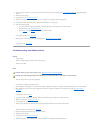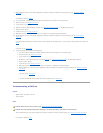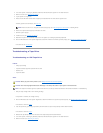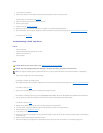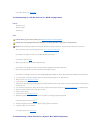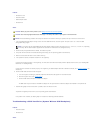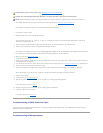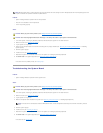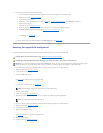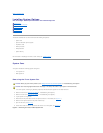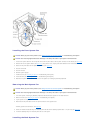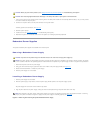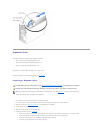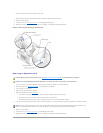
Problem
l System message indicates a problem with the microprocessor
l Heat sink is not installed for the microprocessor
l Fan is not operating properly
Action
1. Turn off the system, including any attached peripherals, and disconnect the system from the electrical outlet.
2. Remove the cover (see "Removing the Cover").
3. Lay the system on its right side.
4. Ensure that the microprocessor and heat sink with cooling fan are properly installed (see "Removing and Installing a Microprocessor" in "Installing
System Options").
5. Stand the system upright.
6. Install the cover (see "Installing the Cover").
7. Reconnect the system to its electrical outlet and turn the system on, including any attached peripherals.
8. Run Quick Tests in the system diagnostics (see "Running the System Diagnostics").
If the tests fail or the problem persists, see "Getting Help."
NOTE: Microprocessors with an internal speed of less than 3.06 GHz use an active cooling heat sink. Microprocessors with internal speeds greater than
orequalto3.06GHzuseapassiveheatsinkandplasticshroud.
CAUTION: Before you perform this procedure, see "Safety First—For You and Your System."
CAUTION: See "Protecting Against Electrostatic Discharge" in the safety instructions in your System Information Guide.
Troubleshooting the System Board
Problem
l System message indicates a problem with the system board
Action
1. Turn off the system, including any attached peripherals, and disconnect the system from the electrical outlet.
2. Remove the cover (see "Removing the Cover").
3. Lay the system on its right side.
4. Remove all expansion cards installed in the system (see "Removing an Expansion Card" in "Installing System Options").
5. Stand the system upright.
6. Install the cover (see "Installing the Cover").
7. Reconnect the system to its electrical outlet and turn the system on, including any attached peripherals.
8. Run Quick Tests in the system diagnostics (see "Running the System Diagnostics").
If the tests fail, see "Getting Help."
CAUTION: Before you perform this procedure, see "Safety First—For You and Your System."
CAUTION: See "Protecting Against Electrostatic Discharge" in the safety instructions in your System Information Guide.
NOTE: If the boot drive is connected to a SCSI or RAID controller card, remove all expansion cards except the controller card used by the boot
drive.



